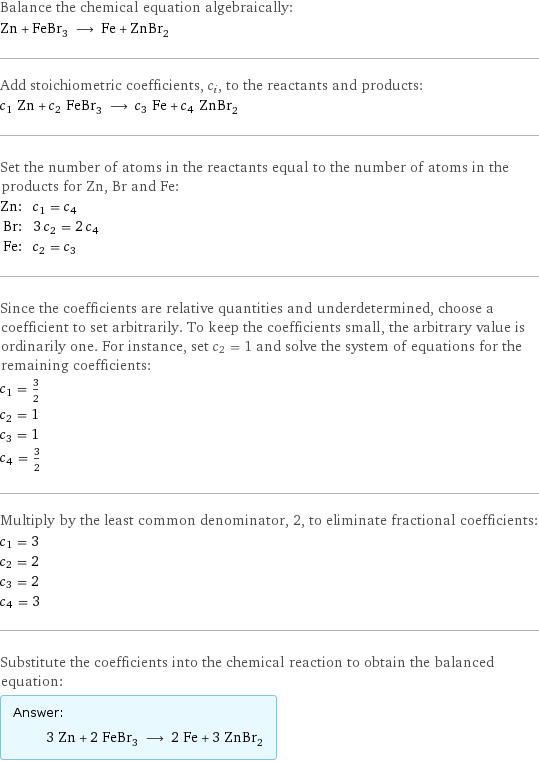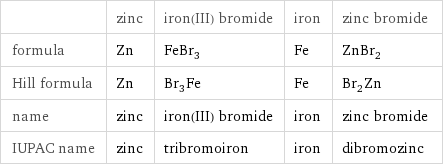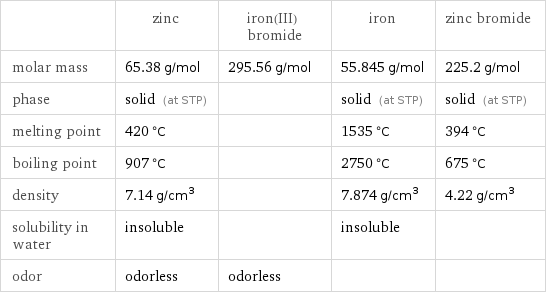Input interpretation

Zn zinc + FeBr_3 iron(III) bromide ⟶ Fe iron + ZnBr_2 zinc bromide
Balanced equation

Balance the chemical equation algebraically: Zn + FeBr_3 ⟶ Fe + ZnBr_2 Add stoichiometric coefficients, c_i, to the reactants and products: c_1 Zn + c_2 FeBr_3 ⟶ c_3 Fe + c_4 ZnBr_2 Set the number of atoms in the reactants equal to the number of atoms in the products for Zn, Br and Fe: Zn: | c_1 = c_4 Br: | 3 c_2 = 2 c_4 Fe: | c_2 = c_3 Since the coefficients are relative quantities and underdetermined, choose a coefficient to set arbitrarily. To keep the coefficients small, the arbitrary value is ordinarily one. For instance, set c_2 = 1 and solve the system of equations for the remaining coefficients: c_1 = 3/2 c_2 = 1 c_3 = 1 c_4 = 3/2 Multiply by the least common denominator, 2, to eliminate fractional coefficients: c_1 = 3 c_2 = 2 c_3 = 2 c_4 = 3 Substitute the coefficients into the chemical reaction to obtain the balanced equation: Answer: | | 3 Zn + 2 FeBr_3 ⟶ 2 Fe + 3 ZnBr_2
Structures

+ ⟶ +
Names

zinc + iron(III) bromide ⟶ iron + zinc bromide
Equilibrium constant
![Construct the equilibrium constant, K, expression for: Zn + FeBr_3 ⟶ Fe + ZnBr_2 Plan: • Balance the chemical equation. • Determine the stoichiometric numbers. • Assemble the activity expression for each chemical species. • Use the activity expressions to build the equilibrium constant expression. Write the balanced chemical equation: 3 Zn + 2 FeBr_3 ⟶ 2 Fe + 3 ZnBr_2 Assign stoichiometric numbers, ν_i, using the stoichiometric coefficients, c_i, from the balanced chemical equation in the following manner: ν_i = -c_i for reactants and ν_i = c_i for products: chemical species | c_i | ν_i Zn | 3 | -3 FeBr_3 | 2 | -2 Fe | 2 | 2 ZnBr_2 | 3 | 3 Assemble the activity expressions accounting for the state of matter and ν_i: chemical species | c_i | ν_i | activity expression Zn | 3 | -3 | ([Zn])^(-3) FeBr_3 | 2 | -2 | ([FeBr3])^(-2) Fe | 2 | 2 | ([Fe])^2 ZnBr_2 | 3 | 3 | ([ZnBr2])^3 The equilibrium constant symbol in the concentration basis is: K_c Mulitply the activity expressions to arrive at the K_c expression: Answer: | | K_c = ([Zn])^(-3) ([FeBr3])^(-2) ([Fe])^2 ([ZnBr2])^3 = (([Fe])^2 ([ZnBr2])^3)/(([Zn])^3 ([FeBr3])^2)](../image_source/13b748bbfed9c30e91c5e9f077149ad4.png)
Construct the equilibrium constant, K, expression for: Zn + FeBr_3 ⟶ Fe + ZnBr_2 Plan: • Balance the chemical equation. • Determine the stoichiometric numbers. • Assemble the activity expression for each chemical species. • Use the activity expressions to build the equilibrium constant expression. Write the balanced chemical equation: 3 Zn + 2 FeBr_3 ⟶ 2 Fe + 3 ZnBr_2 Assign stoichiometric numbers, ν_i, using the stoichiometric coefficients, c_i, from the balanced chemical equation in the following manner: ν_i = -c_i for reactants and ν_i = c_i for products: chemical species | c_i | ν_i Zn | 3 | -3 FeBr_3 | 2 | -2 Fe | 2 | 2 ZnBr_2 | 3 | 3 Assemble the activity expressions accounting for the state of matter and ν_i: chemical species | c_i | ν_i | activity expression Zn | 3 | -3 | ([Zn])^(-3) FeBr_3 | 2 | -2 | ([FeBr3])^(-2) Fe | 2 | 2 | ([Fe])^2 ZnBr_2 | 3 | 3 | ([ZnBr2])^3 The equilibrium constant symbol in the concentration basis is: K_c Mulitply the activity expressions to arrive at the K_c expression: Answer: | | K_c = ([Zn])^(-3) ([FeBr3])^(-2) ([Fe])^2 ([ZnBr2])^3 = (([Fe])^2 ([ZnBr2])^3)/(([Zn])^3 ([FeBr3])^2)
Rate of reaction
![Construct the rate of reaction expression for: Zn + FeBr_3 ⟶ Fe + ZnBr_2 Plan: • Balance the chemical equation. • Determine the stoichiometric numbers. • Assemble the rate term for each chemical species. • Write the rate of reaction expression. Write the balanced chemical equation: 3 Zn + 2 FeBr_3 ⟶ 2 Fe + 3 ZnBr_2 Assign stoichiometric numbers, ν_i, using the stoichiometric coefficients, c_i, from the balanced chemical equation in the following manner: ν_i = -c_i for reactants and ν_i = c_i for products: chemical species | c_i | ν_i Zn | 3 | -3 FeBr_3 | 2 | -2 Fe | 2 | 2 ZnBr_2 | 3 | 3 The rate term for each chemical species, B_i, is 1/ν_i(Δ[B_i])/(Δt) where [B_i] is the amount concentration and t is time: chemical species | c_i | ν_i | rate term Zn | 3 | -3 | -1/3 (Δ[Zn])/(Δt) FeBr_3 | 2 | -2 | -1/2 (Δ[FeBr3])/(Δt) Fe | 2 | 2 | 1/2 (Δ[Fe])/(Δt) ZnBr_2 | 3 | 3 | 1/3 (Δ[ZnBr2])/(Δt) (for infinitesimal rate of change, replace Δ with d) Set the rate terms equal to each other to arrive at the rate expression: Answer: | | rate = -1/3 (Δ[Zn])/(Δt) = -1/2 (Δ[FeBr3])/(Δt) = 1/2 (Δ[Fe])/(Δt) = 1/3 (Δ[ZnBr2])/(Δt) (assuming constant volume and no accumulation of intermediates or side products)](../image_source/d268efed58b8b47f6b9b87b6556d6066.png)
Construct the rate of reaction expression for: Zn + FeBr_3 ⟶ Fe + ZnBr_2 Plan: • Balance the chemical equation. • Determine the stoichiometric numbers. • Assemble the rate term for each chemical species. • Write the rate of reaction expression. Write the balanced chemical equation: 3 Zn + 2 FeBr_3 ⟶ 2 Fe + 3 ZnBr_2 Assign stoichiometric numbers, ν_i, using the stoichiometric coefficients, c_i, from the balanced chemical equation in the following manner: ν_i = -c_i for reactants and ν_i = c_i for products: chemical species | c_i | ν_i Zn | 3 | -3 FeBr_3 | 2 | -2 Fe | 2 | 2 ZnBr_2 | 3 | 3 The rate term for each chemical species, B_i, is 1/ν_i(Δ[B_i])/(Δt) where [B_i] is the amount concentration and t is time: chemical species | c_i | ν_i | rate term Zn | 3 | -3 | -1/3 (Δ[Zn])/(Δt) FeBr_3 | 2 | -2 | -1/2 (Δ[FeBr3])/(Δt) Fe | 2 | 2 | 1/2 (Δ[Fe])/(Δt) ZnBr_2 | 3 | 3 | 1/3 (Δ[ZnBr2])/(Δt) (for infinitesimal rate of change, replace Δ with d) Set the rate terms equal to each other to arrive at the rate expression: Answer: | | rate = -1/3 (Δ[Zn])/(Δt) = -1/2 (Δ[FeBr3])/(Δt) = 1/2 (Δ[Fe])/(Δt) = 1/3 (Δ[ZnBr2])/(Δt) (assuming constant volume and no accumulation of intermediates or side products)
Chemical names and formulas

| zinc | iron(III) bromide | iron | zinc bromide formula | Zn | FeBr_3 | Fe | ZnBr_2 Hill formula | Zn | Br_3Fe | Fe | Br_2Zn name | zinc | iron(III) bromide | iron | zinc bromide IUPAC name | zinc | tribromoiron | iron | dibromozinc
Substance properties

| zinc | iron(III) bromide | iron | zinc bromide molar mass | 65.38 g/mol | 295.56 g/mol | 55.845 g/mol | 225.2 g/mol phase | solid (at STP) | | solid (at STP) | solid (at STP) melting point | 420 °C | | 1535 °C | 394 °C boiling point | 907 °C | | 2750 °C | 675 °C density | 7.14 g/cm^3 | | 7.874 g/cm^3 | 4.22 g/cm^3 solubility in water | insoluble | | insoluble | odor | odorless | odorless | |
Units
